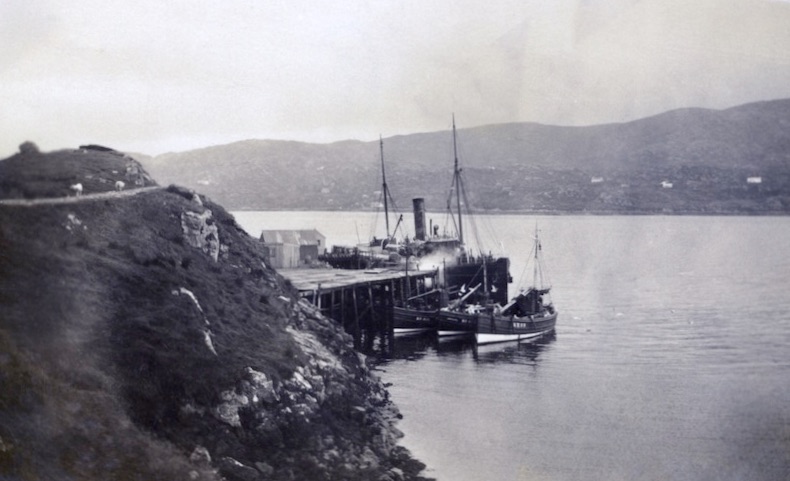
Dunara Castle at Scalpay Pier in 1933. Martin Orme’s ‘all the way’ passenger and cargo steamer was a staple of Hebridean life from her inception in 1875 until she was broken up 1948. Copyright Andrew Clark
Colin Tucker looks back on the history of ferry services to an island that was once the epitome of Hebridean isolation but, for the past 20 years, has been connected by bridge to wider civilisation.
The ferry wades across the kyle. I drive
The car ashore
On a trim tarred road. A car on Scalpay?
Yes and a road where never was one before.
(from ‘Return to Scalpay’ by Norman MacCaig)
The history of the Scalpay car ferry service has been well documented in Robert Beale and John Hendy’s excellent book Scotland’s Turntable Ferries. Also well known is the service the island received from David MacBrayne’s Lochmor, operating thrice weekly to Tarbert on the mainland of Harris from 1928 to 1964. It was not a satisfactory link because, although the journey took only half an hour, it was not possible to travel and return the same day.
But before the car ferry service was inaugurated in 1965, there were other ferries linking Scalpay with the outside world. It would appear that the first ‘regular’ service linking Scalpay with Tarbert started in 1926. The boat used was Surf, a small open motor launch. She also provided a link with the community of Rhenigidale, which until 1990 had no road access.
Surf had previously been used to carry passengers from Kyle of Lochalsh to Kyleakin. She was purchased in 1926 by the late Donald Morrison, a Scalpay merchant, who travelled with his father and another man to Kyle to collect her.
The journey back was not uneventful, as this report, which appeared in the Stornoway Gazette in 1970, makes clear:
On leaving Kyle the day was not so favourable with a stiff south westerly breeze. The crossing of the Minch has always been a worry to passengers even in bigger boats.
Roderick, the eldest of the crew ordered the mast and mainsail to be rigged and with the 6.7hp engine more speed and buoyance could be obtained.
On leaving Trodday the wind came up to Force 8-9 and it can be visualised what it was like in an open boat. The crew, however, kept their bearings and cared for the waves by spilling lubricating oil to counteract the breakers.
Relatives and fishermen in Scalpay got anxious when it went round that the boat was on the way but at 6pm the “Surf” rounded Aird Point and sailed into the North Harbour, to be greeted by a crowd of well-wishers, and the crew were none the worse of their experience during their eight to nine hours in the Minch.
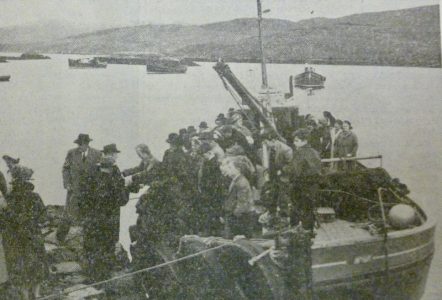
Morea started operating at Scalpay in 1948. She is pictured unloading passengers for the induction of a new minister. Another significant arrival aboard Morea was Santa in 1954
Delivery of present-day ferries will never be as hazardous as that! Surf remained in Scalpay for the next 45 years, although it is not known how many of those years were spent as a ferry. She was sold in 1970 to a new owner in Stornoway. The Gazette reported that she had ‘always been kept in good sailing order’, and that ‘if she is taken care of she will last another forty-five in Stornoway’, adding that ‘there are bound to be many scattered between the far corners of the world who will remember taking passage on the “Surf”.’
Another ferry between Scalpay and Tarbert commenced operation in 1939, operated by Messrs Norman Macleod of Harbour View, Scalpay. The first vessel under their employ was Brothers Pride. She was not specially designed for the service, being merely one of the large fleet of fishing vessels worked by the Scalpay people. She had been registered in 1929 as SY61 and was only 26 feet in length. Brothers Pride served as the ferry throughout the years of the Second World War, and was gratefully remembered later by many servicemen who were enabled to reach home on leave.
In 1948 Norman Macleod obtained a new fishing boat, Morea (register number SY795), to replace Brothers Pride. At just over 42 feet in length she was a larger vessel. She had originally fished out of Girvan and was described as being ‘built on very fine lines’ and having ‘all modern equipment’, including a searchlight apparatus and ‘electricity throughout’. It is not known how regular or frequent the service was in the early years, but from 1956 onwards the service was provided daily.
As well as serving as the island’s regular ferry, Morea on occasions provided assistance to the Scalpay people. In April 1948, for example, she carried out a rescue mission: three men were on the Shiant Islands attending to sheep when one of them became ill. The following day his condition had worsened and attempts were made to communicate with Scalpay by fire beacon. It was not until 4am the following morning that the signal was picked up by the Glas Island Lighthouse keepers, who immediately informed Norman Macleod.
At 5.30am he and a willing crew set off in Morea to the Shiants. The patient was taken on board the vessel which then made full speed for Tarbert. On arrival a car took the ill man to hospital in Stornoway. The Stornoway Gazette reported that ‘The speedy “Morea” is a great boon in emergencies, as is the promptitude with which her skipper acts.”
The people of Scalpay no doubt considered the ship and her skipper ‘a great boon’ in normal circumstances as well.
In December 1950 severe snowstorms and gales blocked the road between Stornoway and Tarbert. Morea made a special run to Stornoway one afternoon to bring back mails, milk and perishables.
It was not always plain sailing. In March 1954 the Gazette reported ‘Ferry Boat Adrift after Search’. A doctor and police constable from Tarbert had been called to Scalpay to search for a missing woman, who sadly was found drowned. In the early hours of the next morning, when the two men were on their way back to Tarbert aboard Morea, the vessel developed engine trouble. In complete darkness, with hail and sleet falling, and visibility practically nil, she drifted helplessly before the wind. At daybreak they found they were just off the rocky shore near Diraclete, on the south side of Loch Tarbert.
Eventually the crew of Donald Macleod (the owner’s son) and his 16 year-old brother managed to get the engine started and Morea was able to reach Tarbert under her own power.
In more normal circumstances, a journey from Tarbert to Scalpay on Morea was a very relaxed affair, as this description evocatively shows:
I enquired at the pier about the boat for Scalpay. “Aye, she’s round the corner,” came the unhurried reply. Aboard the “Morea”… we were soon engaged in conversation, and it was not long before a bag of sweeties was proffered from the wheelhouse. The short sail down East Loch Tarbert was over far too quickly. The journey over the still water had something of enchantment about it; behind us the hills round Tarbert were black against a flaming sky, and ahead were the white houses of Scalpay, sprinkled thickly on the south-west shore.
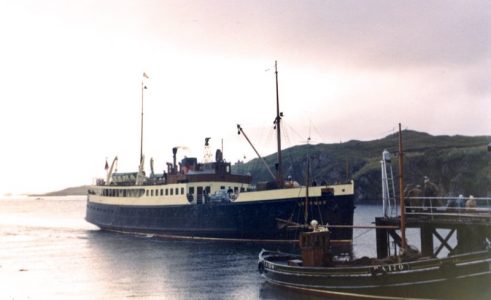
MacBrayne’s Lochmor, pictured approaching Tarbert in 1960, provided a regular connection between Scalpay, Harris and the mainland from 1930 until she was withdrawn in 1964. Copyright CRSC
There were happy occasions and sad ones. In 1954 Santa arrived aboard Morea. A year later the boat was being used to transport the coffin of a well-known Scalpay resident on his last journey to a cemetery on Harris. The Gazette poignantly noted that Lochmor dipped the Red Ensign in silent tribute when Morea came abreast on her way to Tarbert with his remains.
The value of the ferry was also shown in October 1957 when Lochmor was unable to call at Scalpay due to a strong westerly wind. The seven passengers were able to reach the island thanks to Morea making the crossing to Tarbert. This would not have been a unique occasion: the Gazette commented that this was ‘the first miss of the season’.
Much as the ferry service to Tarbert was valued by the islanders, it was not considered to be a satisfactory link with Harris. The feeling was strongly represented at a public meeting in November 1957, at which ‘only one topic got a real airing — the Ferry Project.’ A proper service across Scalpay Sound was considered a ‘must’ to prevent the island dying, and ‘the responsible authority should, without delay, be making the necessary preparations in the way of siting, surveying and estimating so that the project could be ready to start as soon as possible.’
One Scalpach recalled that it had taken 50 years of writing and agitation to construct a road on the island, and hoped it would not take as long to provide a short ferry crossing. Another proposed a bridge, adding ‘why not in this sputnik age?’ It did not take 50 years for both to be provided, but it still took a long time after that meeting.
The matter then seems to have lain dormant until 1963. In January a letter appeared in the Gazette, from ‘Impartial Observer.’ It contained the suggestion that if the longer sea crossing to Tarbert were the favoured option, then why not ‘logically’ extend this to a ferry direct from Scalpay to Stornoway, given that the distance by sea was about 45 miles as against 21?
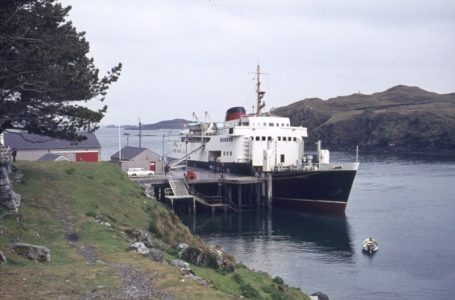
Hebrides, one of the new breed of MacBrayne car ferries in 1964 (pictured at Tarbert in June 1975), was unable to call at Scalpay, partly because of her size but also due to the poor state of the island’s pier. Her arrival put the future of Scalpay’s links with the outside world in jeopardy, and prompted the setting up of a short sea ferry crossing across the Sound of Scalpay. Copyright CRSC J.T.A. Brown Collection
This was, of course, written tongue-in-cheek, for the writer went on to support the ferry across the Sound to Kyles Scalpay. He also suggested that in time a ferry would prove inadequate, a bridge being the only satisfactory solution. But then he stated, ‘A bridge from Tarbert to Scalpay will never materialise.’
The response came a month later, from ‘Ferry Fiend’. Referring to the idea of a bridge across the Kyles, he wrote ‘What palpable ignorance. Does he really believe the Ministry of Transport would even entertain the idea?’
This letter came after the Western Isles Tourist Association had come out in support of the short ferry crossing. Their arguments included the statement that it would be in the interests of the people of Scalpay to make the island as accessible as possible to tourists.
Shortly afterwards, in February 1963, another public meeting was held on Scalpay to discuss the proposed ferry. It was attended not only by some 80 island residents,, but also Captain Cowan of David MacBrayne Ltd, J. Macleod, the company’s Stornoway manager, and Ian Hilleary, convenor of Inverness County Council Roads Committee. The last mentioned opened the proceedings by saying that originally it had been intended to operate a passenger-only service, but now it was thought provision should be made for carrying cars. The imminent arrival of Hebrides (MacBrayne’s first car ferry, at that time under construction in Aberdeen) had made the situation an urgent one. Unlike Lochmor she would not be calling at Scalpay’s pier, which was in a very ‘sad state’, such that even MacBrayne’s cargo ship Lochdunvegan would no longer be able to call. It was pointed out that the cost of upgrading the pier would be considerable.
A representative of the Department of Agriculture and Fisheries noted that a vehicular service between Scalpay and Tarbert would not work because ‘there would need to be cranes and special facilities to lift the vehicles off and on from the pier.’
After further discussion the following conversation took place between Mr Hilleary and the islanders:
‘Do you wish to be linked to the mainland?’
Cries of ‘Yes’.
‘If you [still want] the sea trip from Scalpay to Tarbert you will never get a car ferry service. Personally, I feel that a short sea crossing would be the ideal thing for you.’
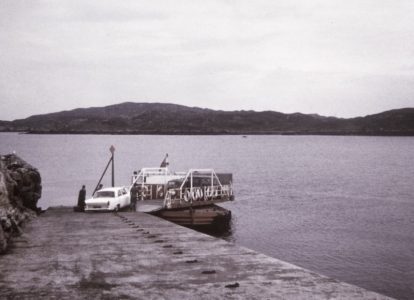
The turntable ferry Scalpay took up the service across the Sound in 1965. She is pictured at Kyles Scalpay in August 1966. Copyright CRSC Archive Collection
A vote was taken and the majority of the islanders were in favour of a vehicular service. This was followed by support from the local councillor, stating that Inverness County Council were justified in their attitude towards the short crossing, adding ‘So let us now hope the scheme will be speeded up and an adequate service given to the Scalpay people.’
Just over two years later, in May 1965, a turntable ferry service started operating between Scalpay and Kyles Scalpay. It seemed like a long time since the initial public meeting, but it was nothing like the 50 years prophesied then.
This was not the end of service to Tarbert provided by Morea. When the car ferry Scalpay was off service in October 1966 for her annual overhaul, Morea and another fishing boat, Catriona, provided a service to Tarbert. Catriona (registration SY200) was a 43-foot vessel registered in 1959 and owned by Donald MacSween. In 1967 no replacement vessel was provided. Possibly an ad hoc service was operated by local fishing vessels, but there are no reports of this.
The direct service to Tarbert continued: every weekday morning Morea carried the mails to and from Tarbert. It would also have been a boon to those without cars. In December 1966 a report stated that the ‘Post Office had a very busy time,’ and ‘Morea kept up to the time-table well and delivery all through (the Christmas period) was highly satisfactory.’
The service finally came to an end on 30 September 1967. Since 1956 the mails had been carried by Norman Macleod and his sons on Morea. During those 11 years only one day’s sailing had been missed. However, they decided not to extend the contract with the Post Office. From the beginning of October, the mails were now to be carried by road to Kyles and collected there by the local postman, using the car ferry from Kyles Scalpay.
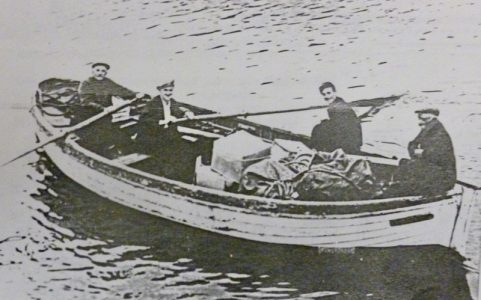
The mid 1960s saw the demise of Plover, a former ship’s lifeboat that had seen many years’ service as a ferry at Scalpay
The end of the service was reported in the Stornoway Gazette under the heading ‘Morea Transport Missed’. It mentioned that ‘The boys of the Morea are to be congratulated for the very fine service they gave to the public and also in conveyance of the mail, which they carried out most conscientiously. There were only a day or two missed owing to very severe weather during all the time they did the run. The weekly Wednesday run to Tarbert was also most convenient and the service is going to be missed greatly by people attending the surgery and the dentist.’
Just over two years later, at the end of November 1969, Morea left Scalpay for the last time, bound for a new home in Dumbarton. Like most ferries she was remembered fondly, as a writer in the Gazette described:
There will be many over a wide area who will remember their experiences on the Morea while journeying between Scalpay and Tarbert. There were calm days and days not so calm, blizzards, storm force winds, dark and unpleasant nights, but the Morea kept time through all.
The efficiency of the crew was most worthy of praise. [This comprised] Norman Macleod, with his sons James, Donald, Donald John and John Angus, not forgetting Murdo, who was always standing by as replacement. Any time of night or day Mr Macleod and his able crew were on the alert for urgent calls and many a cold wintry night they were roused from their beds to fetch a doctor or take an ambulance case to Tarbert.
There are a few in the island who can remember the rough crossings. One woman passenger . . . can recall a stormy day when she had to stretch out on the deck on the fo’c’sle all the way to Tarbert.
The Morea has left us then with sad and very pleasant memories and the name will always be recalled owing to the various missions she so successfully undertook for the community.
The coming of the car ferry and the demise of Lochmor also meant the end of another small ferry at Scalpay. This was Plover, a former ship’s lifeboat. She was an important part of Scalpay life for many years, being used to ferry mail and other goods between the inner North Harbour and the pier at Cuddy point where Lochmor would tie up. Plover had no engine, using only oar power. The two Campbell brothers who manned her would invariably be helped by willing volunteers, especially in bad weather.
For many years, then, ferries of one kind or another were an essential part of life on Scalpay. Today they are all gone. To reach the island we merely have to drive over a bridge, and while doing so, we can look down and see the deserted ferry slipways.
But of the boats which linked Scalpay to Tarbert there are no remnants – we can only think of them as memories.
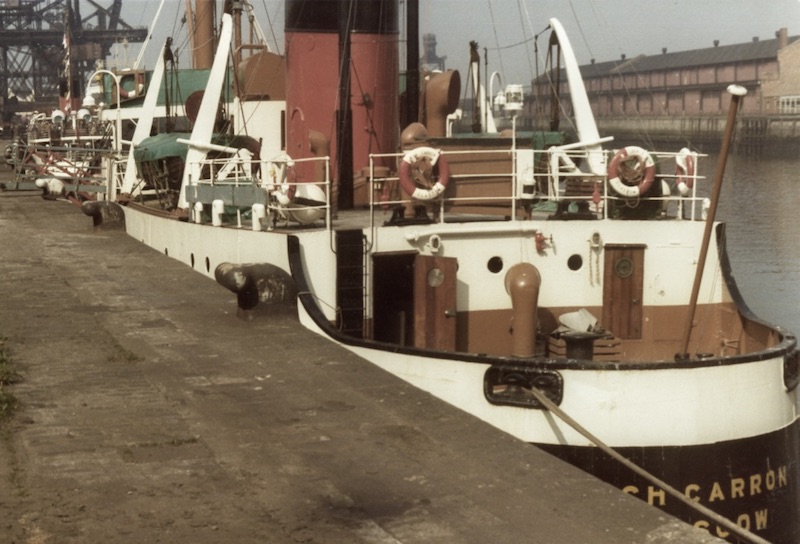
With the boom in car ferry traffic, the MacBrayne cargo boats had no job left to do. Loch Carron, pictured at Springfield Quay in Glasgow, was the last to be sold in the mid 1970s. Copyright CRSC Archive Collection
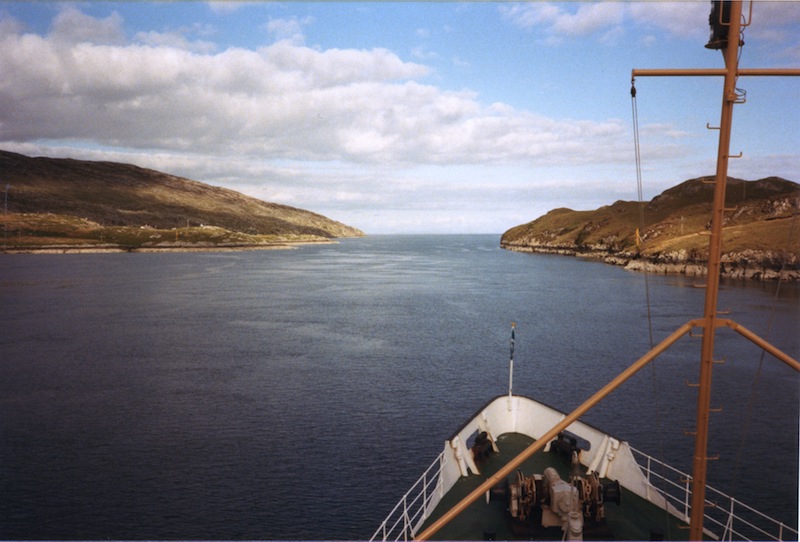
The 1964 Hebrides on one of her rare passages through the Sound of Scalpay. Copyright John Murdo Macmillan
Also by Colin Tucker:
Lochs and Lochs, or ‘sailing in home waters’
Crossing the Minch — Variations on a Theme
Colin Tucker’s widely admired book Steamers to Stornoway is available in the CRSC Shop.
Catch up with all CRSC’s posts at News & Reports













